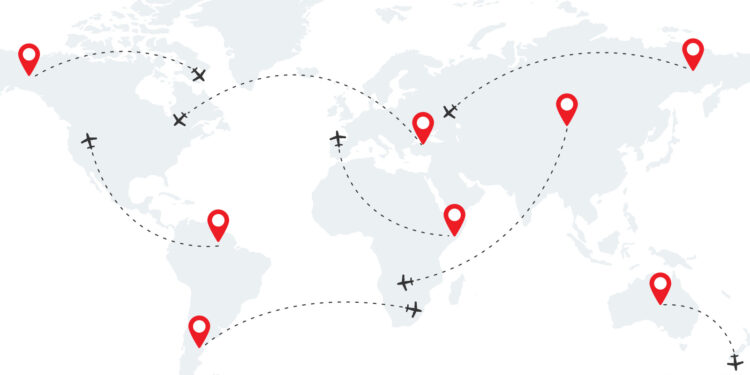European Region Flight Planning Tips

This business aviation blog post continues from our article last week entitled “Flight Planning Tips When Operating to Asia“.
Network Manager (NM), or Network Management Operations Centre (NMOC) – previously known as the Central Flow Management Unit (CFMU)– is the operational unit of Eurocontrol and responsible for airspace management in Europe from the north edge of Africa, including Morocco, west to Ireland, north to Finland and as far east as Azerbaijan. While flight planning procedures in Europe are generally straight-forward – with no particularly onerous requirements or processes – it’s always best to “know before you go” in terms of NM procedures and mandates. Best practice is to review flight planning requirements with your 3rd-party provider prior to operations into NM airspace.
The following is an overview of what you need to know:
1. When did the CFMU name change?
The change in name from CFMU to NM follows the nomination by the European Commission (EC) in 2011, of Eurocontrol as the single entity responsible for network management in Europe under the long-term “Single European Sky” initiative.
2. What are key flight planning tips for Europe?
It is recommended to include the Runway Visual Range (RVR) [in meters] capabilities on your flight plan. Landing RVR information may be used for flow management during low visibility conditions to regulate the traffic flow to those aerodromes. Be aware that some city pairs have capping levels. You may be planning to fly “high and fast” only to find out that a particular city pair has a capping level that keeps you down, at slower speeds, and higher fuel burns. When planning a height monitoring unit (HMU) check, be aware that you don’t have to fly right over the top of a HMU for an accepted measurement. Due to restrictions some countries impose on airways it’s not always feasible to fly directly over the HMU check points. Most Civil Air Authorities (CAAs) allow operators to fly up to 45 miles out from HMU check points for an accepted measurement.
3. Be aware of mandated equipment requirements?
The entire area covered by NM requires you to have VHF 8.33 KHz radio spacing. If you do not have this capability operations will be restricted to below FL195. By January 1, 2018, Eurocontrol aims for full deployment in all European airspace without exception, while some countries like Germany have already implemented 8.33 spacing lower than flight level (FL) 195. Some states/regions – including Belgium, Czech Republic, France, Germany, the London terminal area and Netherlands – require transponders to be Mode S with enhanced surveillance (EHS) capability. As of September 2014, the requirement for EHS and automatic dependent surveillance-broadcast (ADS-B) has been delayed. Aircraft with a certificate of airworthiness issued after June 8, 2016, is now required to be equipped with both EHS and ADS-B. On June 7, 2020, all aircraft exceeding 5,700 kg or having a max cruising true airspeed capable of 250 knots (TAS) or greater will be required to have ADS-B and EHS. The Controller-pilot data link communications (CPDLC) requirement over European skies was also delayed until February of 2020.
4. Are equipment exemptions possible?
There are specific exemptions to equipment for state and military flights, and for all other flights inquiries can be made to each individual state the flight will be operating in.
5. Can random routes be used in this region?
As of July 2017, there has been Free Route Airspace (FRA) implemented across all portions of the European skies. There are now large portions of airspace that no longer have any route structure and are solely Free Route. Even those countries who have maintained an ATS route structure allow direct routes between designated waypoints. Outside of the FRA, operators must stick to routes that are approved based on definitions found in the Route Availability Document (RAD).
6. Are permits required for private flights?
Permits are not required for most private non-revenue flights within Europe, unless it is an experimental flight.
7. Are there special ATC procedures to consider?
All ATC procedures in Europe are based on the RAD. Should ATC determine that they need to delay your flight you’ll be issued with an airway slot.
8. Any special pre-validation requirements for flight plans?
All flight plans may be checked for validation on NM’s website. Assuming your 3rd-party provider is set up appropriately with NM they’ll receive various update messages identifying the status of your flight.
9. Are there particular coding or processing requirements when filing flight plans in Europe?
It’s important to remember that departures from any country that’s part of Eurocontrol’s DFMU IFPS Zone (IFPZ) be filed with NM and not with local ATC.
10. Additional Reading: Flight Planning Tips
Note: Links will be updated as articles are published.
- Part 1 – flight planning tips for the Asian region
- Part 2 – flight planning tips for the European region
- Part 3 – flight planning tips for the North American region
Conclusion
In order to take advantage of most efficient routings within European and Eurocontrol airspace onboard equipment must meet current mandated requirements. As these airborne equipment requirements are continually evolving it’s important to be aware of both current and future regulatory requirements within this busy/ popular operating environment.
Stay tuned for Part 3, which covers flight planning tips when operating to the North American region.
Questions?
If you have any questions about this article or would like assistance flight planning in Europe, contact us at adamdowley@univ-wea.com or jasondavidson@univ-wea.com.




